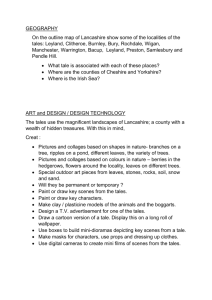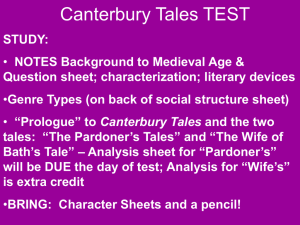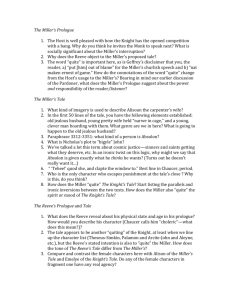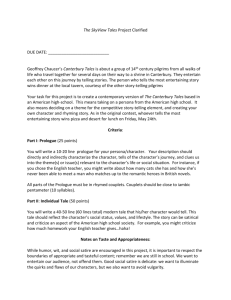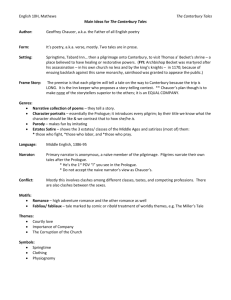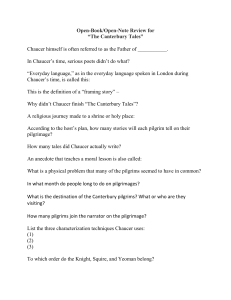Frag I Redux - The University of West Georgia
advertisement
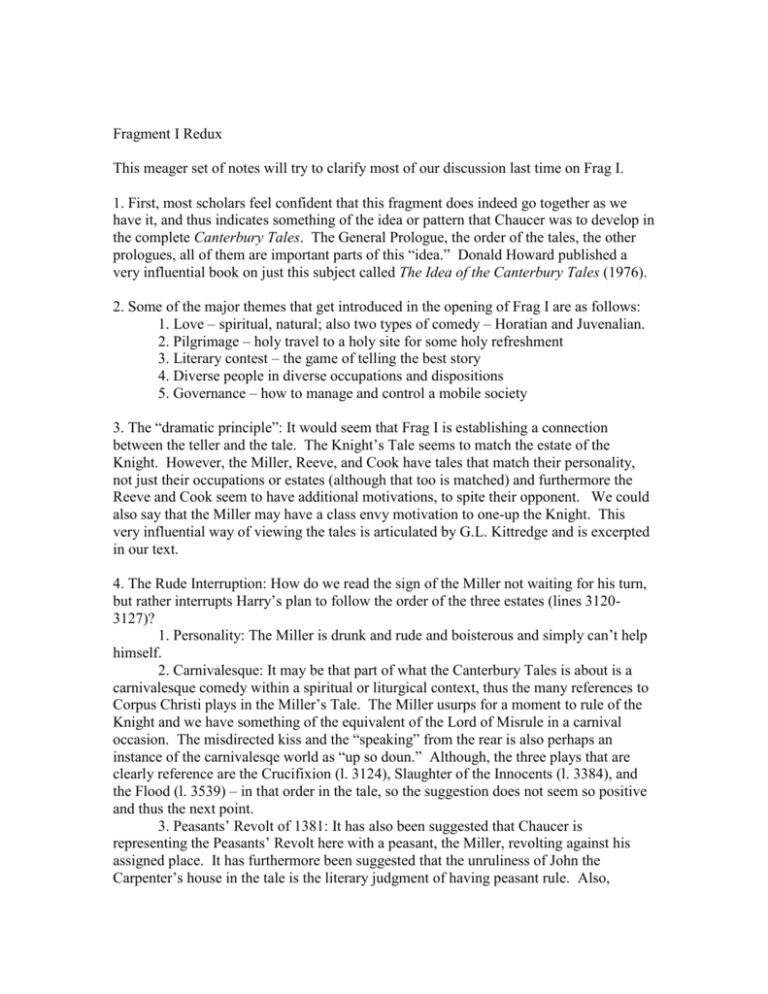
Fragment I Redux This meager set of notes will try to clarify most of our discussion last time on Frag I. 1. First, most scholars feel confident that this fragment does indeed go together as we have it, and thus indicates something of the idea or pattern that Chaucer was to develop in the complete Canterbury Tales. The General Prologue, the order of the tales, the other prologues, all of them are important parts of this “idea.” Donald Howard published a very influential book on just this subject called The Idea of the Canterbury Tales (1976). 2. Some of the major themes that get introduced in the opening of Frag I are as follows: 1. Love – spiritual, natural; also two types of comedy – Horatian and Juvenalian. 2. Pilgrimage – holy travel to a holy site for some holy refreshment 3. Literary contest – the game of telling the best story 4. Diverse people in diverse occupations and dispositions 5. Governance – how to manage and control a mobile society 3. The “dramatic principle”: It would seem that Frag I is establishing a connection between the teller and the tale. The Knight’s Tale seems to match the estate of the Knight. However, the Miller, Reeve, and Cook have tales that match their personality, not just their occupations or estates (although that too is matched) and furthermore the Reeve and Cook seem to have additional motivations, to spite their opponent. We could also say that the Miller may have a class envy motivation to one-up the Knight. This very influential way of viewing the tales is articulated by G.L. Kittredge and is excerpted in our text. 4. The Rude Interruption: How do we read the sign of the Miller not waiting for his turn, but rather interrupts Harry’s plan to follow the order of the three estates (lines 31203127)? 1. Personality: The Miller is drunk and rude and boisterous and simply can’t help himself. 2. Carnivalesque: It may be that part of what the Canterbury Tales is about is a carnivalesque comedy within a spiritual or liturgical context, thus the many references to Corpus Christi plays in the Miller’s Tale. The Miller usurps for a moment to rule of the Knight and we have something of the equivalent of the Lord of Misrule in a carnival occasion. The misdirected kiss and the “speaking” from the rear is also perhaps an instance of the carnivalesqe world as “up so doun.” Although, the three plays that are clearly reference are the Crucifixion (l. 3124), Slaughter of the Innocents (l. 3384), and the Flood (l. 3539) – in that order in the tale, so the suggestion does not seem so positive and thus the next point. 3. Peasants’ Revolt of 1381: It has also been suggested that Chaucer is representing the Peasants’ Revolt here with a peasant, the Miller, revolting against his assigned place. It has furthermore been suggested that the unruliness of John the Carpenter’s house in the tale is the literary judgment of having peasant rule. Also, Absolon or Absalom from the Bible is a figure of a traitor. Finally, the role of the miller was used explicitly in tracks of revolt and protest. (See the Letter of John Ball, one of the Peasants’ Revolt leaders.) 5. The Descent of Love: Even the GP is about love, but certainly the first three tales are about love-making at the very least. It would seem that while the GP introduces both kinds of love, spiritual and physical, that the treatment of love steadily declines from the Knight’s Tale to the Cook’s Tale. What is the point here? It could be a further reflection on 1381; the lower we go in social class the lower the quality of loving. This would be consistent with aristocratic literature of the Middle Ages. (However, there are counter examples in other tales, particularly the Clerk’s Tale). It is hard not to see the world represented in these tales as increasingly base and sour as the tales move from ancient Greece to London. It might just be a satire on London. But it may also be a political satire on capitalism in that the tales move from an increasing commodification of love and sex and a concomitant decrease in spiritual value. The differences between the Knight’s and the Cook’s tales are obvious, but note also the differences between the Miller’s and Reeve’s tales for the same pattern. 6. Generic Diversity: Chaucer seems to be showing off his literary skills here as well. We have in the GP a mixture of styles which includes an estates satire and the setting up of a frame narrative. Included also are prologues that function like monologues for the characters. The rest of the genres are epic-romance in KT and fabliaux in MilT and RvT and perhaps another one in Cook Tale. It could be that Chaucer has in mind linked narratives like those of Ovid’s Metamorphosis, the text from which he gets the Seyes and Alcyone story that he tells in BD. Ovid’s is a frame narrative of sorts, telling all the stories of Roman mythology and linking them by the theme of transformation or change or metamorphosis. Here Chaucer seems to be linking the tales in Frag I by retribution or requiting among the tellers as well as linking them by themes within the tales. It is interesting that the Miller requites the Knight’s romance with a fabliau, a link of generic opposition. Then, the Reeve requites the Miller’s tale of a carpenter with a tale of a miller, a link by estate assassination. Finally, the Cook will requite the Reeve’s tale of mis-lodging with his own tale of miscreants mis-lodged, which may be directed against Harry Bailey. 7. Stylistic Diversity: Finally, you cannot help but notice that the styles change along with social class but also genre. This is not airtight, however; the Miller speaks in ways that don’t match the style and likewise the Reeve. Even in the Knight’s Tale one can find what might be breaches of stylistic decorum or generic requirement. These breaches could just be the difference between modern expectations and medieval ones. (Stylistics consistency is not a university idea or desire.) These breaches could also indicate something more subtle about the less than perfect match between representation and reality. 8. Religious Diversity: Fragment 1 begins by introducing themes of pilgrimage and the love of god and Saint Thomas but the tales quickly move us into very different territory. First the Knight’s Tale is completely pagan, so the religious values introduced in the General Prologue are in a sense tested in a non-Christian environment. The subsequent tales are explicitly Christian but ones that seem to mock clerical values. In the Miller’s Tale Nicholas’ and Absolon’s use of learning, for the clerisy, is subordinated to sex. The use of Cycle plays of biblical material are part of the scheme against John the Carpenter. The figure of Absolon, which may derive from his namesake in Samuel II is a figure of a buffoon and his use of the Song of Songs might strike one as sacrilegious. Likewise, in the Reeve’s tale the characters seem to reduce everything to money and getting even. The Miller Symond may be an allusion to the sin of simony which is the misuse of religious office for the purpose of making money. This is even clear when we learn why Symond is so concerned about his daughter’s virginity. (See lines 3981-3986; he is wounded at the thought of her tainted “lynage” [l. 4272]). Finally, the two “clerks” here do not represent very much in the way of priestly aspirants.

